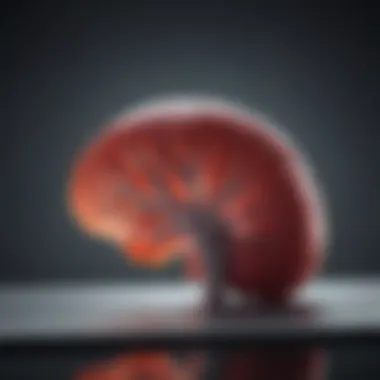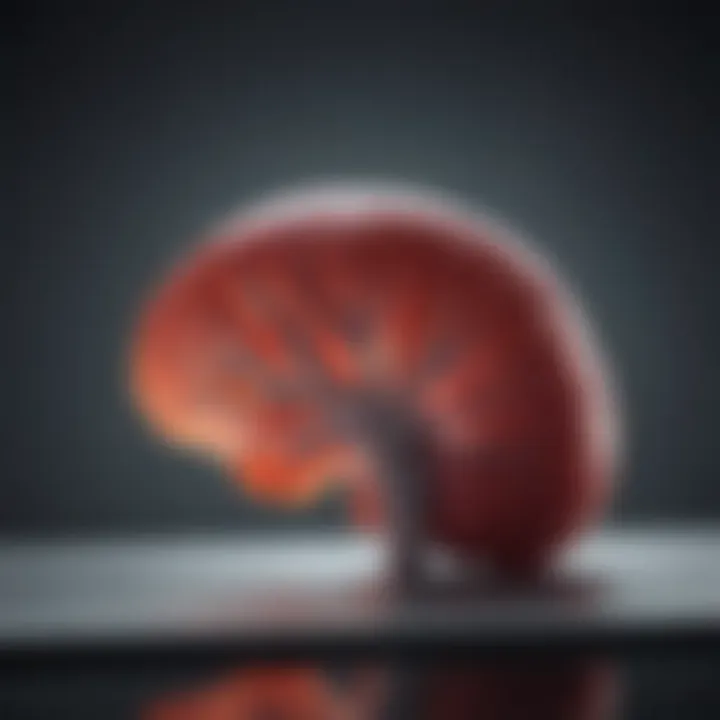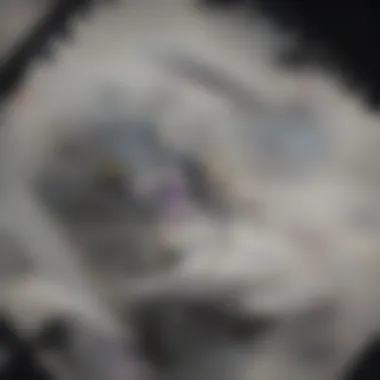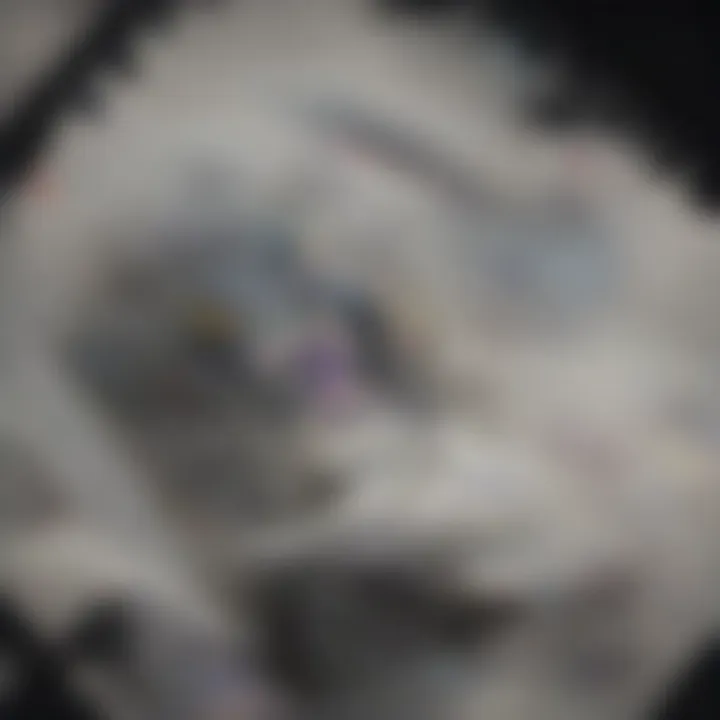Hepatic Cysts: In-Depth Analysis and Management


Intro
Hepatic cysts are common findings in liver imaging, presenting as fluid-filled sacs within the liver. Their formation can be attributed to various factors, including congenital anomalies, infections, or other pathological processes.
Understanding these cysts goes beyond mere recognition in imaging studies. It involves a comprehensive grasp of their developmental pathways, potential risks, and implications for patient management. The focus of this article is to provide an intricate examination of hepatic cysts, exploring their types, diagnostic approaches, and treatment options in detail.
Research Overview
Key Findings
Research indicates that the majority of hepatic cysts are benign and asymptomatic. Most people may never know they have them. However, in rare instances, these cysts can mimic more serious conditions or lead to complications, such as infections or hemorrhage. Emerging research stresses the importance of distinguishing between simple cysts and more complex lesions. Understanding this distinction aids healthcare professionals in minimizing unnecessary interventions.
Study Methodology
Various studies employ imaging modalities like Ultrasound, CT scans, and MRI to identify and classify hepatic cysts. These methods enhance not only the diagnosis but also the monitoring process.
Background and Context
Historical Background
Hepatic cysts have been recognized for centuries, with early medical texts hinting at liver-related abnormalities. However, a more systematic study of these lesions emerged in the 20th century. Early imaging techniques, such as X-rays and limited ultrasound, provided only a partial glimpse into the liver's complexities.
Current Trends in the Field
Today, advanced imaging techniques are at the forefront of hepatic cyst diagnosis. The use of contrast-enhanced imaging has revolutionized our ability to characterize cysts accurately. Moreover, there is a growing interest in understanding the genetic basis of cyst formation, particularly in conditions like Polycystic Liver Disease. This knowledge is paving the way for personalized treatment approaches and interventions.
"Advancements in imaging technologies significantly enhance the ability to differentiate between cystic lesions, leading to improved patient outcomes."
The exploration of hepatic cysts continues to evolve, with new studies shedding light on their management, potential risks, and underlying mechanisms. As we delve deeper into the subject, the need for awareness among healthcare professionals and researchers becomes increasingly evident.
Intro to Hepatic Cysts
Understanding hepatic cysts is crucial for both medical professionals and those engaged in healthcare research. These fluid-filled sacs appear in the liver and can pose various clinical implications. Their presence can be benign or indicate more serious conditions. Knowledge of hepatic cysts aids in diagnosing, managing, and ultimately treating the patients affected. This article aims to unpack the complexity surrounding hepatic cysts and their significance in clinical practice.
Definition and Characteristics
Hepatic cysts are defined as fluid-filled sacs that develop within the liver. They can vary in size, shape, and origin. Most commonly, these cysts are simple, having a thin wall and containing clear, serous fluid. Characteristics of simple hepatic cysts include:
- Size Variation: Simple cysts can be small (a few millimeters) or large, measuring several centimeters in diameter.
- Symptoms: More often than not, these cysts are asymptomatic. However, when they reach significant size, they may cause abdominal discomfort.
- Benign Nature: Typically, these cysts are non-neoplastic and do not progress to malignancy.
On the other hand, complex hepatic cysts may have thicker walls or contain non-clear fluid. These are more concerning and often require further evaluation, as their characteristics might mimic malignant lesions. This highlights the need for careful observation and potential intervention.
Historical Overview of Hepatic Cysts
The study of hepatic cysts has evolved significantly over the years. Historically, hepatic cysts were largely misunderstood, often misdiagnosed and sometimes confused with tumors. Early imaging techniques made it challenging to differentiate between various lesions. However, advancements in imaging technology, particularly ultrasound and MRI, have improved the accuracy of diagnosis.
Over the past few decades, medical literature has expanded on the mechanisms leading to the formation of cysts. Researchers began identifying various congenital conditions linked to hepatic cysts, like autosomal dominant polycystic kidney disease, which frequently co-occurs with liver cysts.
With this increased understanding, the management of hepatic cysts has also progressed. The focus has shifted to a more conservative approach for asymptomatic cysts while establishing clear intervention protocols for symptomatic cases or those exhibiting worrisome features.
"As imaging technology improves, so does the understanding of hepatic pathology, leading to better patient outcomes."
In summary, recognizing the definition, distinct characteristics, and historical context of hepatic cysts lays a foundation for grappling with their clinical significance and implications. Understanding these elements is fundamental in shaping effective diagnostic and treatment strategies.
Types of Hepatic Cysts
Understanding the various types of hepatic cysts is essential for clinicians, researchers, and students. This knowledge enables accurate diagnosis, effective management, and the identification of potential complications. Hepatic cysts can arise from different etiological factors and may display unique characteristics that influence treatment options. By distinguishing between the types of cysts, one can appreciate their clinical significance and adapt management strategies accordingly.
Simple Hepatic Cysts
Simple hepatic cysts are the most common type of liver cysts, often discovered incidentally during imaging studies. These cysts are typically unilocular, fluid-filled sacs that are generally asymptomatic. Their formation may be due to developmental anomalies during embryogenesis. Simple cysts are usually round or oval in shape and may vary in size from a few millimeters to several centimeters in diameter.
Most importantly, simple hepatic cysts are benign and have little to no associated risk. They do not require any specific treatment unless complications arise, such as infection or rupture. In most cases, periodic monitoring is sufficient. Imaging studies like ultrasound can easily identify these cysts, aiding in their differential diagnosis from other liver lesions.
Complex Hepatic Cysts
Complex hepatic cysts present a greater challenge in comparison to simple cysts. These lesions may contain internal echoes, septations, or solid components, indicating potential neoplastic transformations. Such characteristics necessitate further evaluation through advanced imaging techniques, as they raise the suspicion for malignancy or other serious conditions.
The management of complex cysts often requires a multidisciplinary approach. Depending on the imaging findings, surgical intervention may be recommended to obtain a definitive diagnosis through histopathological examination. In some cases, observation and follow-up with periodic imaging may be appropriate if the characteristics remain stable.
Polycystic Liver Disease
Polycystic liver disease is a genetic disorder characterized by the presence of multiple hepatic cysts. This condition commonly occurs in conjunction with polycystic kidney disease. Cysts in this type can be quite large and may lead to significant liver enlargement, resulting in various complications, such as portal hypertension.
The implications of polycystic liver disease extend beyond the presence of cysts. There is a risk of liver insufficiency and raises important considerations regarding transplantation. Genetic counseling may be beneficial for affected individuals and their families.


Cysts Associated with Other Conditions
Cysts can also be associated with other medical conditions, such as infections or tumors. For instance, echinococcal cysts arise from parasitic infections, while cysts may develop in the context of malignancies like liver cancer. Identifying these associations is crucial for appropriate management.
Maintaining a comprehensive view of hepatic cysts assists in understanding their clinical pathways. Medical professionals must consider the broader health implications linked to each type of cyst, as they may necessitate varied clinical responses and interventions.
By delving into the different types of hepatic cysts, one gains insight into their characteristics, significance, and management strategies. This comprehension lays the groundwork for a thorough evaluation and appropriate clinical decision-making.
Etiology of Hepatic Cysts
Understanding the etiology of hepatic cysts provides essential insights into their origins, which can enhance clinical diagnosis and treatment methods. Both congenital and acquired factors play significant roles in the development of these fluid-filled sacs in the liver. Identifying these factors not only aids healthcare professionals in managing patients but also informs potential research directions in hepatic pathology.
Congenital Factors
Congenital hepatic cysts are primarily present at birth. They can result from developmental anomalies during fetal growth. One such condition is the von Hippel-Lindau syndrome, where cysts form in the liver alongside other organ abnormalities.
These cysts can vary in size and number. They often do not cause symptoms, but when they do, it may be due to their size or location exerting pressure on surrounding structures.
Some congenital factors include:
- Genetics: Family history can influence the likelihood of developing cysts.
- Developmental defects: Anomalies during liver formation can lead to cyst presence.
Some professionals suggest that patients with multiple cysts may require ongoing monitoring despite benign nature. This approach reduces risk of complications later.
Acquired Factors
Acquired hepatic cysts typically develop due to various environmental and lifestyle factors. They can arise from liver diseases, trauma, or infections. Understanding these factors assists in managing existing cysts and preventing new ones.
Common acquired factors include:
- Liver diseases: Conditions like liver cirrhosis may induce cyst formation.
- Infections: Parasitic infections, such as echinococcosis, can lead to cystic lesions in the liver.
- Trauma: Past injuries to the liver may result in scarring, contributing to cyst formations.
It’s crucial to identify whether a cyst is congenital or acquired because treatment approaches may differ. For acquired cysts, for instance, managing the underlying condition often leads to cyst regression.
Key Point: Accurate identification of the etiology not only impacts treatment strategies but also shapes future research into prevention and management.
Pathophysiology of Hepatic Cysts
Understanding the pathophysiology of hepatic cysts is crucial for grasping their impact on the liver's function and overall health. The formation and presence of these cysts can influence not only hepatic processes but also the broader metabolic dynamics in the body. By examining the fluid dynamics within cysts and their interaction with surrounding tissue, we can highlight the importance of these structures in liver pathology.
Fluid Dynamics within Cysts
Hepatic cysts are typically filled with a serous fluid which can vary in composition. The dynamics of this fluid play a significant role in the cyst's characteristics and behavior. The fluid can change with the cyst’s development, resulting in variations in pressure and volume that may impact the liver's surrounding tissues. The equilibrium of pressure within cysts is essential for understanding their potential to cause complications, such as rupture.
- Fluid Production: The lining of the cysts secretes fluid, maintaining a constant level of hydration.
- Fluid Absorption: Surrounding tissues may absorb some fluid, influencing the cyst's size over time.
- Hydraulic Forces: The pressure within the cysts can exert hydraulic forces on the liver parenchyma. If pressure levels exceed safe limits, it may lead to discomfort or, in severe cases, rupture.
- Chemical Composition: The analysis of the fluid’s composition can provide insights on whether the cyst is simple or complex, impacting management decisions.
Therefore, a thorough understanding of fluid dynamics is vital for clinicians to assess risk and develop appropriate interventions.
Interaction with Surrounding Tissue
The relationship between hepatic cysts and the surrounding hepatic tissue is another area deserving attention. Cysts rarely exist in isolation; they interact with neighboring structures, and that interaction can have various implications.
- Compression Effects: Large cysts may compress hepatic vasculature or biliary structures, leading to functional impairments. Compression might contribute to biliary obstruction or alter blood flow dynamics.
- Inflammatory Responses: In certain cases, the presence of cysts may provoke localized inflammatory responses, affecting liver function. This could lead to symptoms like pain or discomfort.
- Scarring and Fibrosis: Prolonged presence of cysts can cause changes in the surrounding liver tissue, potentially resulting in scarring or fibrosis. The risk of such complications emphasizes the importance of monitoring asymptomatic cysts.
- Tumor Distinction: Understanding these interactions helps in differentiating benign cystic formations from malignant lesions. This knowledge is critical during diagnostic imaging assessments.
Overall, the interplay between cysts and surrounding liver tissue is complex and fundamental to understanding the clinical significance of hepatic cysts. By exploring these pathophysiological aspects, healthcare professionals can better anticipate complications, plan effective management strategies, and ultimately improve patient outcomes.
Clinical Presentation
The clinical presentation of hepatic cysts plays a crucial role in understanding their impact on patient management and care. Hepatic cysts can manifest in various ways, influencing how they are diagnosed and treated. Given their diverse nature, distinguishing between symptomatic and asymptomatic cysts is significant for clinical outcomes. This distinction shapes clinical decisions, guiding interventions and monitoring strategies.
Symptomatic vs. Asymptomatic Cysts
Hepatic cysts are typically classified into symptomatic and asymptomatic categories. Asymptomatic cysts often do not produce noticeable signs or symptoms. Patients may be entirely unaware of their presence, with these cysts frequently discovered incidentally during imaging for unrelated issues. Despite their silent nature, it's important that practitioners remain vigilant, as changes in size, number, or internal characteristics could indicate a need for follow-up or further investigation.
In contrast, symptomatic cysts can lead to a range of clinical symptoms. Patients may experience discomfort or pain in the right upper quadrant, nausea, or general malaise. In some cases, larger cysts can exert pressure on surrounding structures, leading to digestive complaints or even obstructive symptoms. The management approach for symptomatic cysts often includes diagnostic imaging followed by potential interventions, underlining the necessity for clinicians to assess symptomatology carefully.
Diagnostic Challenges
Diagnosing hepatic cysts is not without its challenges. Health care professionals often encounter various types of hepatic lesions that may resemble cysts on imaging studies. Differentiating between simple cysts, complex cysts, and other hepatic masses requires meticulous interpretation of imaging results.
Ultrasound imaging is a first-line tool, but its limitations can complicate the diagnostic process. For instance, complex cysts can show mixed echogenicity, making it difficult to ascertain the nature of the lesion. Similarly, while CT scans are more definitive, overlapping features with tumors may lead to misdiagnosis, requiring further evaluation such as MRI for clarification.
The importance of meticulous diagnostic work cannot be overstated. Correctly identifying the nature of a hepatic cyst is vital. Misinterpretation can lead to unnecessary stress for the patient or inappropriate treatment strategies. Thus, improving diagnostic protocols and training for radiologists is essential in addressing these challenges.
A solid understanding of the clinical presentation of hepatic cysts lays the foundation for effective management and patient care.
Diagnostic Imaging Techniques


The diagnosis of hepatic cysts relies significantly on imaging techniques. These methods are crucial for accurate identification and assessment of these fluid-filled sacs in the liver. Diagnostic imaging helps differentiate between simple and complex cysts, guide management strategies, and monitor evolution over time. A comprehensive understanding of these techniques enables health professionals to make informed decisions, minimizing the risk of misdiagnosis.
Ultrasound Imaging
Ultrasound imaging is often the first-line diagnostic tool for hepatic cysts. It is non-invasive and does not involve exposure to ionizing radiation. The procedure uses sound waves to create images of the liver’s structure. One major benefit is that it is widely available and relatively inexpensive compared to other imaging methods.
In ultrasound, hepatic cysts typically appear as well-defined, anechoic (dark) areas. They may exhibit posterior acoustic enhancement, which indicates that they are filled with fluid. However, ultrasound has limitations. It may not provide sufficient detail for small lesions or allow differentiation between cysts and solid masses. Therefore, a follow-up with another imaging technique may be necessary.
CT Scan and MRI
Both Computed Tomography (CT) and Magnetic Resonance Imaging (MRI) are highly effective for visualizing hepatic cysts. CT scans offer a more detailed view of the liver, showing the cyst's size, location, and the presence of any complications like infection or rupture. They are particularly useful in complex cases where ultrasound findings are inconclusive. The use of contrast agents in CT enhances the visibility of cysts and surrounding tissues.
MRI, on the other hand, provides excellent soft tissue contrast and is particularly beneficial for assessing cysts' characteristics. It is advantageous in distinguishing between different types of lesions within the liver. An important aspect of MRI is that it can evaluate cysts in the context of the liver's overall health. Additionally, for patients with allergies to iodinated contrast used in CT, MRI serves as a suitable alternative.
Differentiation from Other Lesions
Accurate differentiation between hepatic cysts and other lesions is essential. Various liver pathologies can mimic the appearance of hepatic cysts on imaging studies. Among these are liver abscesses, hemangiomas, and even malignancies.
Certain imaging features are vital in distinguishing these conditions:
- Cystic lesions generally appear round or oval, with well-defined borders and fluid content.
- Abscesses may show irregularities in shape and can have internal echoes due to debris.
- Hemangiomas, which are benign vascular tumors, usually exhibit a characteristic enhancement pattern when imaged.
Ultimately, a detailed assessment using the appropriate imaging technique allows for the correct diagnosis of hepatic cysts, reducing the need for invasive procedures. This knowledge contributes to better management strategies tailored to individual patient needs.
Management Strategies
Management strategies for hepatic cysts are crucial in the context of this article. These strategies help determine the best course of action for patients diagnosed with hepatic cysts based on their type, symptoms, and underlying causes. Proper management can prevent complications and maintain overall liver health. Key elements to consider include observation for asymptomatic cysts, interventional techniques for symptomatic cases, and surgical options for complex cysts. Each approach comes with its own benefits and considerations, balancing intervention with patient well-being.
Observation and Follow-Up
Observation is often the first approach for managing simple hepatic cysts, especially when they are asymptomatic. Regular follow-up imaging can help ensure any changes in size or characteristics are detected early. This strategy minimizes unnecessary procedures while keeping patient safety as a priority. Key points for effective observation include:
- Routine Imaging: Periodic ultrasound or MRI can provide important information about the cyst's status.
- Symptom Monitoring: Patients should report any new symptoms promptly.
- Patient Education: Providing information about what to expect and when to seek help can empower patients.
"Most hepatic cysts are benign and do not require treatment. Thus, observation is a valid strategy for many cases."
Interventional Techniques
When hepatic cysts cause symptoms, interventional techniques might be necessary. These approaches are used to alleviate discomfort or complications arising from the cysts. The most common techniques include:
- Aspiration: This method involves using a needle to remove fluid from the cyst, often providing immediate relief.
- Sclerotherapy: After aspiration, a sclerosing agent may be introduced to prevent fluid from re-accumulating.
- Percutaneous Catheter Placement: In some cases, a catheter is inserted for continuous drainage, especially in larger cysts.
These techniques are generally minimally invasive, allowing for faster recovery times compared to traditional surgery. Each patient's situation can guide the choice of intervention.
Surgical Management
Surgical management comes into play when cysts are complex, symptomatic, or associated with other liver conditions. Surgical options vary based on the cyst characteristics and may include:
- Cystectomy: Total removal of the cyst may be required if it poses risks such as infection or significant compressive symptoms.
- Liver Resection: In some cases, part of the liver may need to be removed, especially if cysts are abundant and affect function.
- Shunting Procedures: These aim to redirect fluid away from the cyst to reduce pressure in the liver.
Surgical interventions tend to have higher risks and longer recovery times compared to other methods, making thorough evaluation essential before proceeding. The decision may involve a team of specialists to assess the best option for the patient's needs.
In summary, the management strategies for hepatic cysts encompass a range of techniques from observation to surgical options. Each strategy is vital in addressing the individual needs of patients and ensuring optimal health outcomes.
Potential Complications
Understanding the potential complications associated with hepatic cysts is crucial for both diagnosis and treatment. Although many cysts are asymptomatic and benign, the possibility of complications can impact patient outcomes significantly. Recognizing these risks allows healthcare providers to make informed decisions and develop appropriate management strategies.
Infection and Inflammation
Infection of a hepatic cyst can lead to significant clinical issues. When a cyst becomes infected, it may result in symptoms such as abdominal pain, fever, and elevated white blood cell counts. The inflammation associated with the infection can further complicate diagnosis and treatment. Infected cysts may become abscesses, which require additional interventions. Prompt diagnosis through imaging techniques such as ultrasound or CT is essential in these cases. It allows for timely treatment, which may include antibiotics or even percutaneous drainage. Studies have shown that infected hepatic cysts can pose a threat to liver function, making awareness of this complication vital for clinicians.
Key points regarding infection in hepatic cysts:
- Infection can occur in both simple and complex cysts.
- Symptoms may resemble other abdominal conditions, complicating diagnosis.
- Treatment typically requires antibiotics, and in severe cases, surgical intervention.
Rupture of Hepatic Cysts
Rupture of hepatic cysts may be another serious complication. Although rare, it can lead to significant morbidity. Commonly, rupture occurs in larger cysts, particularly those categorized as complex. The rupture can result in internal bleeding or spillage of cystic fluid into the peritoneal cavity, causing acute abdominal pain and perhaps peritonitis.
Management of a ruptured cyst frequently requires emergency medical attention. Immediate imaging can help assess the rupture's extent. If bleeding is significant, surgical intervention may be necessary to control hemorrhage and prevent further complications.
Considerations for a ruptured cyst include:
- Monitor larger cysts closely for growth and potential rupture.
- Educate patients about signs of rupture, such as severe pain and abdominal distension.
- Ensure prompt treatment to minimize complications.


"Awareness of potential complications from hepatic cysts is essential in managing patient health and can significantly influence outcomes."
The importance of understanding these complications cannot be overstated. They highlight the need for continuous patient monitoring, appropriate imaging, and timely intervention when complications arise, ensuring better overall patient care.
Prognosis and Outcomes
The prognosis of hepatic cysts can vary significantly based on several factors, including the type of cyst, the presence of symptoms, and any associated health conditions. Understanding these outcomes is crucial for patients and healthcare professionals alike, as it informs both management strategies and patient expectations.
Long-term Health Implications
Long-term health implications of hepatic cysts generally depend on their classification.
- Simple cysts often present little to no risk and are generally considered benign. Patients with uncomplicated simple hepatic cysts can expect stable health without noticeable impacts over time. In many cases, these cysts are discovered incidentally and require no treatment or surveillance.
- Complex cysts may need more careful consideration. They can sometimes be associated with other hepatic conditions, raising concerns about potential malignancy. Patients with complex cysts may undergo further imaging or interventions, which may contribute to increased anxiety or health care utilization without necessarily impacting their long-term health.
Patients with conditions like polycystic liver disease may face different implications. This genetic condition often results in multiple cysts that can lead to complications such as organ dysfunction or portal hypertension over time.
Overall, the long-term implications can be favorable for most individuals with hepatic cysts, especially if proper surveillance measures and follow-ups are followed. Patients should maintain regular check-ups to monitor any changes in their symptoms or cyst characteristics.
Recurrence of Cysts
The recurrence of hepatic cysts is a notable consideration in patient management. Studies indicate that certain types of cysts, especially simple cysts, do not typically recur after removal or intervention. However, patients with underlying conditions, such as polycystic liver disease, may experience a higher rate of recurrence due to the nature of their disorder.
Key factors about recurrence include:
- Incidental Findings: Many simple cysts are discovered incidentally during imaging for unrelated conditions.
- Surgical Resection: For cysts that have been surgically removed, the risk of recurrence tends to be low, but persistent follow-up is advised.
- Monitoring: Regular imaging may be necessary for patients with known complex cysts or those at risk of malignancy.
It is also important for patients to undergo genetic counseling if they have a family history indicative of conditions that lead to cyst formation. Vigilance in follow-up can mitigate risks related to recurrence, ensuring appropriate action is taken if new cysts develop or existing ones change in character.
"Managing hepatic cysts effectively requires a nuanced understanding of their characteristics; however, most cases do not lead to significant long-term complications."
In summary, the prognosis for individuals with hepatic cysts is generally optimistic, tempered by the specifics of each case. Regular monitoring and proactive management are essential elements that contribute to positive outcomes.
Recent Research Developments
Recent advancements in the understanding and management of hepatic cysts have crucial implications for clinical practice. Research in this area highlights the evolution of diagnostic methods and therapeutic strategies. Continuous progress is necessary since many patients remain undiagnosed or misdiagnosed. The importance of this research cannot be overstated, especially considering the impact on patient outcomes and the potential to inform future treatment protocols.
Advancements in Imaging Technologies
Imaging technologies have transformed the diagnostic landscape for hepatic cysts. Innovations such as high-resolution ultrasound, contrast-enhanced ultrasound, and advances in Magnetic Resonance Imaging (MRI) play a vital role in distinguishing between different types of cysts. These tools allow better characterization of cystic lesions, enabling practitioners to make informed decisions based on size, content, and potential complications.
Recent studies indicate that dynamic contrast-enhanced MRI provides a better identification of complex cysts, which are otherwise challenging to evaluate through standard imaging techniques. Additionally, Artificial Intelligence (AI) advancements are now contributing to quicker and more accurate interpretations of imaging results. AI algorithms can analyze patterns that may not be apparent to the naked eye, improving diagnostic accuracy and leading to prompt management.
"The integration of AI in medical imaging represents a paradigm shift in the way we understand and approach hepatic cyst assessments."
Novel Therapeutic Approaches
The landscape of treatment for hepatic cysts is witnessing significant changes. Historically, management often centered around observation and surgical intervention for symptomatic cases. Now, there is a growing trend towards minimally invasive procedures such as cyst aspiration and sclerotherapy, particularly for symptomatic simple and complex cysts.
Recent clinical trials are exploring the efficacy of sclerotherapy, which involves injecting a sclerosing agent into the cyst following aspiration. This method may help to reduce cyst recurrence and manage symptoms effectively while preserving liver function. Moreover, research into pharmacological agents targeting cyst contents is opening new pathways. For instance, the use of agents that can modulate fluid dynamics within cysts is currently under study, showing promise in decreasing cyst size and alleviating patient symptoms.
In summary, ongoing research into imaging advancements and novel therapeutic techniques is critical for enhancing the management of hepatic cysts. This progress is key to providing a framework for future investigations and improving patient care in this field.
Interdisciplinary Perspectives
Understanding hepatic cysts requires an interdisciplinary approach. This topic spans various fields, including gastroenterology, genetics, imaging technology, and surgery. Each discipline offers distinct insights that deepen the overall comprehension of these conditions and enhance clinical practices.
Collaboration among specialists allows for a more comprehensive analysis of hepatic cysts. For instance, gastroenterologists focus on the clinical implications, including symptomatic presentations and treatment options. Geneticists contribute by identifying hereditary aspects of conditions like polycystic liver disease. This integrative perspective can improve diagnostic accuracy and lead to personalized medicine approaches.
Role of Genetics
Genetics plays a significant role in understanding hepatic cysts. Certain genetic conditions predispose individuals to develop cysts, notably autosomal dominant polycystic kidney disease (ADPKD) and syndromic disorders like von Hippel-Lindau disease. These genetic links underscore the importance of family history in diagnosis and management.
Additionally, genetic research provides insight into the mechanisms of cyst formation. Mutations in specific genes can disrupt normal cellular processes, resulting in abnormal cyst development. This knowledge emphasizes the need for genetic counseling and testing in patients with a family history of liver cysts.
Impact on Liver Function and Metabolism
Hepatic cysts can affect liver function and overall metabolic processes, although many are asymptomatic. When cysts grow large, they may compress liver tissue or adjacent structures. This compression can lead to complications, including bile duct obstruction and impaired liver function.
The presence of multiple cysts, as seen in polycystic liver disease, can significantly affect liver function over time. Studies show that patients with larger liver volumes due to cysts might be at higher risk for liver-related complications. Thus, assessing the metabolic impact of cysts is crucial for effective management.
Overall, the interdisciplinary perspectives on hepatic cysts highlight the necessity of collaboration among various fields. Doing so fosters a comprehensive approach to diagnosis, treatment, and ongoing research, ultimately benefiting patient care.
Summary and The Ends
The examination of hepatic cysts reveals a complex yet essential area of study within liver health. This article has underscored several critical dimensions regarding the presence and implications of hepatic cysts. Understanding these factors is vital for healthcare professionals and researchers alike, as it shapes clinical practices and guides future inquiries.
The significance of summary and conclusions lies in synthesizing the insights gathered throughout the article. The variety of hepatic cysts, from simple to complex forms, indicates differing etiology, management strategies, and potential complications. Recognizing these differences informs diagnosis and treatment, ensuring optimal patient outcomes. Moreover, it highlights the necessity of ongoing research in this field to adapt to emerging knowledge and technological advancements.
In addition, by addressing key takeaways, this section emphasizes the core findings that practitioners should remember. These include the understanding of cyst characteristics, their clinical relevance, and the importance of appropriate imaging techniques. Such knowledge equips professionals to tackle challenges and deviations in patient presentations more effectively.
Overall, this section aims to encapsulate the essential findings while encouraging future research directions that can lead to breakthroughs in diagnosis and treatment. Enhanced imaging modalities and innovative therapeutic methods hold promise for better management outcomes. Therefore, a commitment to exploring these areas will be instrumental in improving care for patients with hepatic cysts.
"The study of hepatic cysts is not merely an academic pursuit; it affects lives through improved clinical understanding and treatment options."







